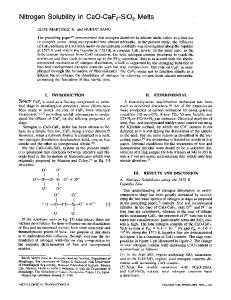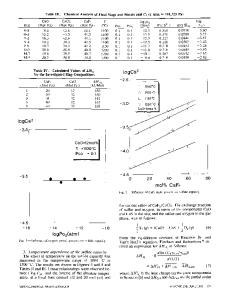Nitrogen solubility in CaO-SiO 2 , CaO-MgO-SiO 2 , and BaO-MgO-SiO 2 melts
- PDF / 671,289 Bytes
- 8 Pages / 603.28 x 783.28 pts Page_size
- 32 Downloads / 375 Views
INTRODUCTION
THE solubility of nitrogen in various slag systems has been studied by several investigators principally to obtain reliable data which can be used for removal of nitrogen from iron and steel as well as for the protection of steel from nitrogen absorption during the last stages of refining and continuous casting, tl,E,3J The recent work by the authors [t~ with the CaO-CaF2 system has proved, among other parameters, that nitrogen dissolution in the melts strongly depends on the activity of the basic component (CaO) of the melt. However, generally, it is not clear whether nitrogen dissolution is enhanced by the presence o f basic or acidic components. [31 Considering the contradictions regarding the role of SiO2 in the nitrogen dissolution [El together with the data of other systems, [L3-51 it became evident that there exist more than one mechanism of nitrogen dissolution into slag melts. At the same time, there is a growing interest by glass scientists in the mechanism of nitrogen dissolution in the so-called "oxynitride glasses.-[6,7,8] They are interested in the form of nitrogen in glasses so as to predict and correlate their physical properties with nitrogen content in glasses and their corresponding structures, t81 On the other hand, the theoretical treatment of silicate melts through a newly developed technique to determine the concentrations of various silicate ions as a function of composition[9'l~ and infrared spectra [1Ll21 provides us with useful knowledge on the dissolution mechanism of nitrogen in the melts. In this study, the solubility of nitrogen in molten CaOSiO2, CaO-MgO-SiO2, and BaO-MgO-SiO2 systems has been measured. Two different dissolution mechanisms are postulated on the basis of experimental results by a newly developed chemical analysis method for nitrogen.
by adding SiaN4 as a source of nitrogen to the slag sample or simply by using the samples without any initial nitrogen in the beginning. Depending on temperatures and, in some cases, compositions, appropriate nitrogen and oxygen partial pressures were chosen by using CO-N2 or CO-Ar-N2 gas mixtures to provide sufficient nitrogen content in the samples and to suppress the generation of SiO. The time required to reach equilibrium ranged from 4 to 40 hours. The graphite crucible had an 8-mm ID, l l - m m OD, and 50-mm height for all o f the experiments. The infrared spectra of the samples were obtained using a Fourier transform infrared (FFIR) apparatus (JEOL JIR 100). Based on the assumption that nitrogen dissolves in slags as a free ion or is associated with silicate ions, the separation of the two types o f nitrogen has been attempted. Namely, the selective dissolution of the slag sample by acetic acid under controlled conditions of temperature, time, and acetic acid concentration (Table I) was devised. After dissolution, the residues were dissolved in HC1 (30 pct) + HF (5 pct) and supplied for nitrogen chemical analysis by the Kjeldahl method. Similarly, the solution was also analyzed for nitrogen. It was observed that no s
Data Loading...











